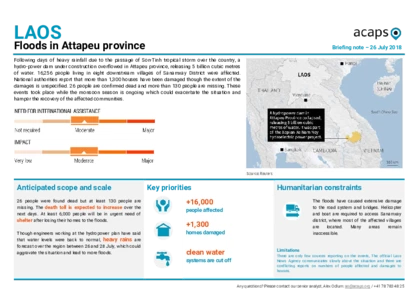Laos is vulnerable to climate hazards, especially floods and storms. Because of poor socioeconomic conditions, the country’s capacity to adapt to extreme weather events is low.
On 7 September 2024, Typhoon Yagi, one of the strongest storms to hit Southeast Asia in decades, made landfall in northern Laos. The typhoon, combined with the southwest monsoon, caused flooding and landslides in both rural and urban areas. The most affected areas were Luang Namtha and Luang Prabang provinces and Vientiane Capital, the capital of the country. Other significantly affected provinces were Bokeo, Oudomxay, Phongsaly, Xayaboury, and Xiangkhouang.
The impact has affected around 200,000 people, including 92,000 who need humanitarian assistance. The floods and landslides have also disrupted road infrastructure and disrupted access to social services, such as education, psychosocial support, and food programmes.
Urgent humanitarian needs include access to food, water, WASH services and supplies (such as personal hygiene items), healthcare support, clothing, nutritional supplements, teaching and learning supplies, and livelihoods.
(WB accessed 01/10/2024, UNICEF 27/09/2024, UNICEF 17/09/2024, WFP 23/09/2024)
Laos is vulnerable to climate hazards, especially floods and storms. Because of poor socioeconomic conditions, the country’s capacity to adapt to extreme weather events is low.
On 7 September 2024, Typhoon Yagi, one of the strongest storms to hit Southeast Asia in decades, made landfall in northern Laos. The typhoon, combined with the southwest monsoon, caused flooding and landslides in both rural and urban areas. The most affected areas were Luang Namtha and Luang Prabang provinces and Vientiane Capital, the capital of the country. Other significantly affected provinces were Bokeo, Oudomxay, Phongsaly, Xayaboury, and Xiangkhouang.
The impact has affected around 200,000 people, including 92,000 who need humanitarian assistance. The floods and landslides have also disrupted road infrastructure and disrupted access to social services, such as education, psychosocial support, and food programmes.
Urgent humanitarian needs include access to food, water, WASH services and supplies (such as personal hygiene items), healthcare support, clothing, nutritional supplements, teaching and learning supplies, and livelihoods.
(WB accessed 01/10/2024, UNICEF 27/09/2024, UNICEF 17/09/2024, WFP 23/09/2024)



